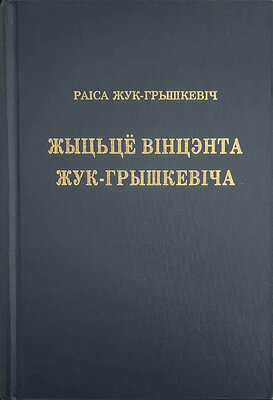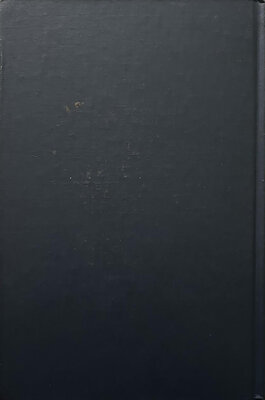Жыцьцё Вінцэнта Жук-Грышкевіча
Раіса Жук-Грышкевіч
Памер: 798с.
Таронта 1993
Я ўжо не бяру пад увагу 33.7% палякаў, што за родную мову падалі ангельскую, хоць і тут ёсьць людзі беларуска-га паходжаньня.
3 усяго вышэй сказанага вынікае, што прыблізная лічба беларусаў у Канадзе выносіць 45,000 пад расейскай рубры-кай і каля 25,000 пад польскай рубрыкай - разам каля 70,000. Як яны разьмешчаны па ўсіх правінцыях Канады -не бяруся разглядаць, бо да такой справы ня маю пад рукой ніякіх матарыялаў. Вам гэта лягчэй будзе зрабіць, паколькі Вы маеце статыстычныя дадзеныя. Думаю аднак, што найбольш беларусаў ёсьць у Антарыё, Квібэку й Манітобе.
225
Мне здаецца, што Ваша лічба 30,000 беларусаў за над-та зьменшаная й некансэквэнтна абаснаваная. Фактычна Вы ўзялі за аснову толькі 13,323 каталікоў з расейскае ру-брыкі (памінаючы напэўна ў тры разы большую лічбу праваслаўных беларусаў у гэтай рубрыцы) ды 7,741 пра-васлаўных з польскай рубрыкі (памінаючы шмат вышэй-шую лічбу беларусаў каталікоў з гэтай рубрыкі) і на ўсякі выпадак крыху павысілі суму гэтых дзьвюх лічбаў, за-кругляючы яе да 30,000. Калі-б Вы нават да лічбы каталі-коў У расейскай рубрыцы прызначылі толькі такой жа вышыні лічбу праваслаўных беларусаў у расейскай ру-брыцы (што было-б таксама зьменшаньнем, бо ведамым фактам ёсьць, што праваслаўных беларусаў куды больш, як каталікоў), ды лічбу праваслаўных у польскай рубры-цы павялічылі на такую-ж лічбу беларусаў каталікоў у гэ-тай рубрыцы - ці інакш кажучы падвоілі гэтыя дзьве ліч-бы, то й то атрымалі-б 42,128 (13,323 плюс 7,741 памножа-ны на 2 дае 42,128). Хоць лічба вельмі абмежаная, усё-ж зь яе вынікала-б, што да лічбы беларусаў каталікоў у ра-сейскай рубрыцы дайшла нязначная лічба беларусаў пра-васлаўных, а да лічбы беларусаў праваслаўных у поль-скай рубрыцы дайшла пэўная лічба беларусаў каталікоў. Зразумелая рэч, што й гэтая лічба была-б нелягічнай, калі ўзяць пад увагу працэнтныя суадносіны паміж беларусамі праваслаўнымі й каталікамі. Але Ваша лічба 30,000 зусім аднабаковая, паколькі яна адкідае праваслаўных белару-саў у расейскай рубрыцы й беларусаў каталікоў у поль-скай рубрыцы. Выбачце мне за крытыку, яна выплывае з таго прынцыпу, што з дыскусіі й крытыкі лягчэй выявіць праўду.
Мне здаецца, што больш чымся адна шостая частка ўсяе лічбы беларусаў у Канадзе ўважае сябе за беларусаў. Нават тыя, што належаць да Расейскай Фэдэрацыі й чы-таюць «Весьнік» і савецкую прэсу, ведаюць, што яны бела-русы, хоць можа й не «самастыйнікі». Нават гэта прэса пі-ша шмат аб беларусах, як асобнай нацыі й Савецкай Бе-ларусі, як асобнай дзяржаве. Варта было-б пазнаёміцца з нумарам «Весьніка» з першай паловы студзеня гэтага го-ду, дзе прысьвячаецца шмат месца 40-вой гадавіне БССР. Я думаю, што каля палавіны беларусаў ведаюць, што яны беларусы. Іншая рэч, што лік беларусаў, якія бяруць ак-тыўны ўдзел у беларускім жыцьці ў Канадзе, значна мен-шы, магчыма адна шостая цэлага ліку.
226
Да разьдзелу “Religious Divisions...”
Перш за ўсё трэба выправіць памылку адносна пра-цэнтных суадносін паміж беларусамі праваслаўнымі й ка-талікамі, згодна з маімі папраўкамі ў разьдзеле «Статы-стыка» на бачыне 4-ай.
Далей я дазволіў сабе зрабіць рэчовыя папраўкі ў Ва-шым тэксьце (выбачце мне), якія аб’ектыўныя й згодныя з праўдай. Іншых заўвагаў ня маю.
Вось і ўсё, што да Вашых тэкстаў.
Цяпер хачу спытаць, ді Вы думаеце апрацаваць, як асобны разьдзел, агульныя інфармацыйныя дадзеныя аб Беларусі, яе сучасным і мінулым, аб чым Вы мне пісалі раней. Мне здаецца, што такі інфармацыйны ўступ ёсьць неабходным. Ці Ваша манаграфія будзе выдана друкам для публічнага ўжытку?
Выбачце, што мой адказ заняў столькі часу. Я быў крыху заняты іншымі справамі, ды прастудыяваньне Ва-шага тэксту й заўвагі да яго таксама вымагалі пэўнага часу. Аднак і надалей буду вельмі рады дапамагчы Вам, калі Вы знойдзеце маю дапамогу карыснай.
3 глыбокай пашанай,
Ваш В. Жук-Грышкевіч»
“Ottawa, April 1, 1959
Dr. V. Zuk
54 Mary Street
Barrie, Ontario
Dear Dr. Zuk:
I read with great interest your kind letter and I appreciate very much your observations, they helped to round up the picture of the Byelorussian ethnic group in Canada.
You will permit me, I am sure, to make a few remarks to your observations.
Ad (1) You state that in Canada the ethnic origin of a person is identified with STATE ALLEGIANCE and that in census returns “origin” was equivalent to state Allegiance. This is not the case. If you consult the Enumeration Manual for the
227
1951 Census, you will find the following instruction given to enumerators:
“You will attempt to establish a person’s origin by asking the language spoken by the person (if he is an immigrant), or by his parental ancestor when he first came to this continent” (“1951 Census, Enumeration Manual” page 44).
Ad (2) Therefore, you are mistaken when you say that the “origin” of a person was fixed according to his or her state allegiance. The criterion for the establishment of origin was the language considered as the mother tongue spoken by the person enumerated if he was an immigrant, or the language of his parental ancestor when he came to Canada. In many cases state alligiance coincided with origin and mother tongue, for instance: a person coming from Italy was in most cases of Italian origin and Italian was his mother tongue. The same applied to immigrants from Denmark, Norway, Sweden, Germany, Netherlands, etc.
If a person has given Byelorussian as his mother tongue, it has to be duly registered on the card of the enumerator. It was not shown in Census publications because there is no room for the inclusion in the Census publications of all lesser language groups and Byelorussian as mother tongue was given only be a small fraction of Byelorussians in Canada.
On the top of it there did exist also a certain confusion in enumerating Byelorussians, and if the enumerators put “Russian” instead of “Byelorussian” origin, it was mainly because: (a) there did not exist a generally accepted and uniform designation for this group. Even now Byelorussians themselves use FOUR different designations, viz. Byelorussian, Belorussian, White Russian, and White Ruthenian. I do not mention those who call themselves Krivitchi. (b) The number of persons who actually gave Byelorussian as their mother tongue and origin, was as cards indicate, extremely small, (c) The enumerators often were not aware of the existance of Byelorussians as a separate group, to them White Russians were Russian refugees from Czarist Russia, (d) And finally -because the (old) Byelorussian immigrants themselves put “Russian” or “Polish” as their mother tongue and their origin. When I visited the Russian Greek Orthodox parish in Winnipeg, in 1925, I could not find a single Byelorussian, although some of the names of parishioners did not sound Russian to me. I took them for Ukrainians from Bukovina and Volhynia, who came to Canada before the first world war and considered
228
themselves “Russians.” The case was not better in 1949. Writes Mikola Silvanovich: “Ja prybu u Vinnipeh u 1949 hodze, heta josc dziesiac hadou tamu, to nichto i nidzie pra Bielarusau nicoha nia viedau.”
Ad (3) Deliberately misstated ethnic origin, changes of names of “nationality” on the part of former Soviet citizens in order to escape forcible repatriation to the Soviet Union have been legally rectified without punishment for making false statements to immigration authorities as early as 1952. Immigrants from Byelorussia applying for Canadian citizenship are free to put in their application forms their Byelorussian origin. They are not obliged to put Russian or Polish origin.
Your observations on the number of Byelorussians in Canada need some rectification. We did not use all figures available to us and we did not explain the studies we made in that field. I shall try to give you only some observations in reply to your queries.
The Russian and Polish origin groups were our main field of study. For that purpose we used first of all census statistics: (a) denominational, (b) language, (c) origin. In addition we made “Stichproben” comparing lists of names of parishioners of Russian Orthodox parishes, lists of members of societies, biographical sketches in the press, etc. On these observations we based our statements in the monograph. You say: “in my opinion not less than half of the 91,279 persons listed as Russians, are in fact Byelorussians.” I am afraid you are mistaken. The denominational statistics revealed the following facts: The 91,279 persons of Russian origin consisted of:
12,219 Greek Orthodox - (Russian, Ukrainian and Byelorussian)
7,5616 Mennonite - (practically all of German origin)
9,118 Jewish - (who did not consider themselves Byelorussian ethnically)
8,259 Lutheran - (mostly Balts)
19,597 Doukhobors - (almost without exception all of Russian racial origin)
13,323 Roman Catholics - (not all of them Byelorussians, as immigration records show)
Apart from those enumerated above there were also others who belonged to various protestant denominations, such as:
10,395 United Church of Canada
3,419 Anglican Church
3,500 Baptists
1,387 Presbyterian
229
It was impossible to trace the ancestry of this group, apart from the fact that most of them (with the exception of Baptists) gave English as their mother tongue and stated that their fathers and grandfathers came from Russia. Baptist congregations, hold their services in Ukrainian and Russian languages and according to clergymen whom we consulted, the majority of their faithful are immigrants from Volhynia, some of whom considered themselves Ukrainians and some Russians.
It is very likely that a fair number of the second and third generation followers of the United Church of Canada, Church of England, and the Presbyterian church, are actually of Byelorussian ethnic origin but they did not state it and we are unable to determine the ratio.
Russian parishes which I visited in Western Canada consisted not of Russian or Byelorussian parishioners but mostly of old immigrants from the Austrian province Bukovina and from Volhynia. The names of the clergy also indicate that they were not of Russian stock, for instance: Rev. V. Bezkorovayny, Maple Creek, Sask; (and so on.... R. Z.-H.)
 КНІГІ ОНЛАЙН
КНІГІ ОНЛАЙН


